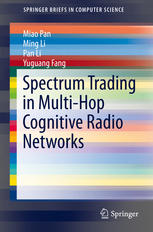Chapter 1 The Network Architecture for Spectrum Trading Abstract In this chapter, we first describe the motivation for the spectrum trading and briefly summarize the state-of-art research about spectrum trading. Then, we present the research challenges for the spectrum trading in multi-hop cognitive radio networks (CRNs). To address those challenges, we introduce a novel network architecture design for spectrum trading in multi-hop CRNs. The proposed CRN architecture design facilitates the opportunistic spectrum accessing of secondary users (SUs) without cognitive radio (CR) capability, helps to harvest and allocate the available spectrum in efficient way, improves the quality of services (QoS) of multi-hop CR communications, and provides possible approach to guarantee the economic properties of spectrum trading. Under this CRN architecture, we also give content outlines for the rest of the three chapters. Keywords Network architecture • QoS • End-to-end performance • Economic properties 1.1 Introduction to Spectrum Trading 1.1.1 From Static Spectrum Auction to Dynamic Spectrum Trading Nowadays, more and more people, families and companies rely on wireless services for their daily life and business, which leads to a booming growth of various wireless networks and a dramatic increase in the demand for radio spectrum. In parallel with that, current static spectrum allocation policy of Federal Communications Commission (FCC) [1, 2, 28] results in the exhaustion of available spectrum, while a lot of licensed spectrum bands are extremely under-utilized. Experimental tests in academia [5, 27] and measurements conducted in industries [26] both show that even in the most crowed region of big cities (e.g., Washington, DC, Chicago, New York City, etc.), many licensed spectrum bands are not used in certain geographical areas and are idle most of the time. Those studies spur the FCC to open up licensed spectrum bands and pursue new innovative technologies to encourage dynamic use of the under-utilized spectrum
چکیده فارسی
چکیده فصل 1 معماری شبکه برای تجارت طیف در این فصل، ابتدا انگیزه تجارت طیف را شرح می دهیم و به طور خلاصه تحقیقات پیشرفته در مورد تجارت طیف را خلاصه می کنیم. سپس، چالشهای تحقیقاتی را برای تجارت طیف در شبکههای رادیویی شناختی چند هاپ (CRN) ارائه میکنیم. برای پرداختن به این چالشها، ما یک طراحی جدید معماری شبکه را برای تجارت طیف در CRNهای چند هاپ معرفی میکنیم. طراحی معماری پیشنهادی CRN دسترسی فرصت طلبانه کاربران ثانویه (SUs) بدون قابلیت رادیو شناختی (CR) را تسهیل می کند، به برداشت و تخصیص طیف موجود به روشی کارآمد کمک می کند، کیفیت خدمات (QoS) ارتباطات CR چند هاپ را بهبود می بخشد. و رویکرد ممکنی را برای تضمین ویژگی های اقتصادی تجارت طیف ارائه می دهد. تحت این معماری CRN، ما همچنین خطوط کلی محتوا را برای بقیه سه فصل ارائه می دهیم. کلمات کلیدی معماری شبکه • QoS • عملکرد سرتاسری • ویژگی های اقتصادی 1.1 مقدمه ای بر تجارت طیف 1.1.1 از حراج طیف ایستا تا تجارت طیف پویا امروزه، افراد، خانواده ها و شرکت های بیشتری برای زندگی روزمره خود به خدمات بی سیم متکی هستند و کسب و کار، که منجر به رشد پررونق شبکه های بی سیم مختلف و افزایش چشمگیر تقاضا برای طیف رادیویی می شود. به موازات آن، سیاست تخصیص طیف استاتیک فعلی کمیسیون ارتباطات فدرال (FCC) [1، 2، 28] منجر به فرسودگی طیف در دسترس میشود، در حالی که بسیاری از باندهای طیف مجاز بسیار کم استفاده میشوند. آزمایشهای تجربی در دانشگاه [5، 27] و اندازهگیریهای انجامشده در صنایع [26] هر دو نشان میدهند که حتی در شلوغترین منطقه شهرهای بزرگ (به عنوان مثال، واشنگتن، دی سی، شیکاگو، شهر نیویورک و غیره)، بسیاری از باندهای طیف دارای مجوز در مناطق جغرافیایی خاصی استفاده نمی شوند و بیشتر اوقات بیکار هستند. این مطالعات FCC را تشویق می کند تا باندهای طیف مجاز را باز کند و فناوری های نوآورانه جدیدی را برای تشویق استفاده پویا از طیف کم استفاده را دنبال کند
ادامه ...
بستن ...
Author(s): Miao Pan, Ming Li, Pan Li, Yuguang Fang (auth.)
Series: SpringerBriefs in Electrical and Computer Engineering
Publisher: Springer International Publishing, Year: 2015
ISBN: 978-3-319-25629-0,978-3-319-25631-3
ادامه ...
بستن ...










